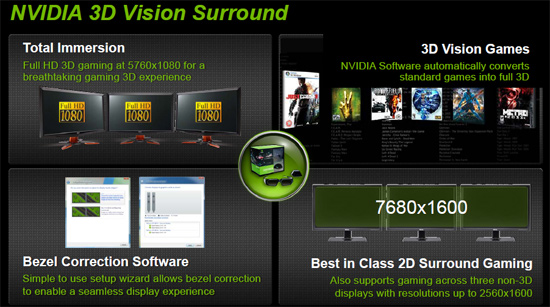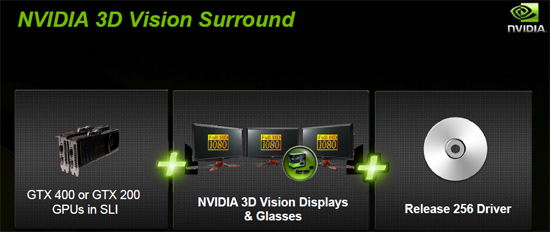3D Vision Surround
NVIDIA spoke a lot about the DirectX 11 support, Tessellation and CUDA. It has even made an attempt to match one of the most talked about features of the Evergreen family, multi-monitor support. AMD has Eyefinity where it can power three monitors with a single card for extreme resolutions and better experience. NVIDIA counters with Vision Surround and for the hardcore users, 3D Vision Surround.

If we first look at the similarities, the obvious is the ability to span the picture across three monitors. AMD has proper bezel correction in Catalyst 10.3, which NVIDIA claims to deliver from day one. If we move on to how the technologies are different from one another there some things worth considering. First of all, the most important, Vision Surround requires two graphics cards, while Eyefinity only needs one. Worth noting is that 3D Vision Surround is limited to 5760×1080 pixels resolution while regular 2D Vision Surround can span up to 7680×1600 pixels.
AMD picked DisplayPort as a joker to power a third monitor without RAMDAC on a single GPU. Eyefinity powers three monitors on a single card, but it does require at least one monitor with DisplayPort input, alternatively an active DVI-to-DisplayPort adapter. NVIDIA Vision Surround is even worse in our opinion since it requires two graphics cards and with a price tag of GeForce GTX 480 of $500 per card you don’t have to be a math wiz to calculate that it will cost you a lot to run Vision Surround with NVIDIA’s new flagship. NVIDIA’s has an advantage, the technology is driver dependent, not hardware reliant.

This means that Vision Surround and 3D Vision Surround isn’t just supported by GeForce GTX 400 but also the older GTX 200 series, as long as you have two cards. The support for 3D Vision Surround is currently only in beta drivers, but NVIDIA says that the ForceWare Release 256 drivers that are due in April will unlock this feature.
Sadly we couldn’t test NVIDIA Vision Surround since we only have one card, but we will try to look at both Vision Surround and 3D Vision Surround in the future.
Without having tested AMD’s and NVIDIA’s multi-monitor technologies head to head it is hard to judge them. Both technologies have their pros and cons. NVIDIA is the only one with 3D support, but with high system requirements and cost it is a far more exclusive technology than Eyefinity.

















